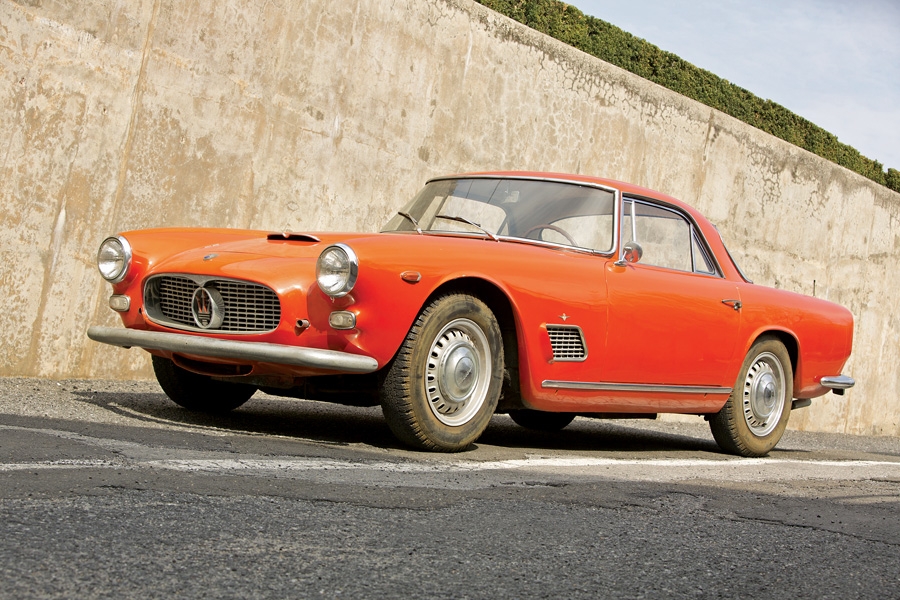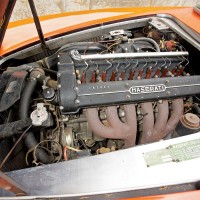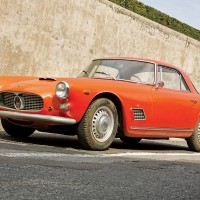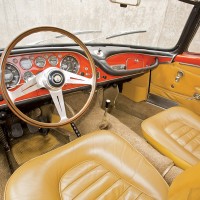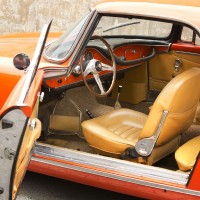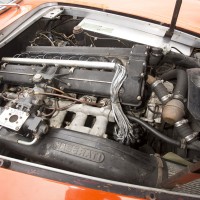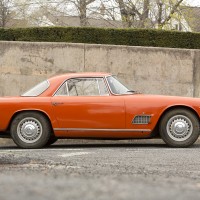SCM Analysis
Detailing
| Vehicle: | 1963 Maserati 3500 GTi Coupe |
| Number Produced: | 1,991 |
| Original List Price: | $13,600 |
| Tune Up Cost: | $1,750 |
| Distributor Caps: | $279 |
| Chassis Number Location: | Engine compartment on firewall |
| Engine Number Location: | Stamped on side of block |
| Club Info: | Maserati Club International |
| Website: | http://www.maseratinet.com |
| Investment Grade: | C |
This car, Lot 323, sold for $176,000, including buyer’s premium, at Bonhams’ Greenwich, CT, sale on June 1, 2014.
The presentation and sale of this car touch upon several of what I consider to be among the most provocative issues in the current collector car market. When I received my assignment from Executive Editor Chester Allen, I had a moment of paralysis. I wondered how I could possibly limit myself to the approximately 1,000 words desired when I was sure I could do a fairly hefty book instead.
What are those issues? The market movement of “undervalued” cars, the appeal of the “original/barn find/preservation/virgin restoration candidate,” and auction presentation and the way vehicles are marketed were those in my mind.
I gathered myself and began to organize a plan of attack. First, I hadn’t been able to attend the sale. My challenge was that making a determination if the car was near — or past — the tipping point from preservation to restoration is best made with the vehicle under your fingertips. Failing that opportunity, I turned to SCM’s man on the ground in Greenwich, Adam Blumenthal, to give me a detailed view of what he observed.
Adam shared that he was “…really drawn to the car.” And that part of the appeal was “…its dull and dusty presentation” which “…lent the car real character and excellent patina.” However, he also noted a certain “…disconnect between its condition and low miles — a mere 31,378.” He considered it far from a barn find, not least because it actually ran, and he felt strongly that it appeared to be a “largely original” example that would benefit from cleaning but shouldn’t be “sanitized” with a full restoration. He firmly felt it to be in the land of preservation.
A long undervalued car
I’ve written more times that I can count (but I’m sure there are SCMers out there who can and will tell me) that I feel just about every car Maserati built before 1980 is woefully undervalued relative to the cars which would qualify for inclusion in what we appraisers refer to as the Principle of Substitution. It is an exercise not unlike that of the well-known “which doesn’t belong?” question from the SAT. If you couldn’t have an Aston Martin DB4, which other 6-cylinder, DOHC, 2+2 GT coupe might you buy? You see where I went there. The Italian Aston is indeed the equivalent of the British Ferrari.
Prices for Astons have made a steady rise from 2009 to today, but a nice DB4 Saloon could be had for around $100k in 2005 — at the very same time that a very nice 3500 GT was not much less, about $70k. The Aston is now trading for four times the price of the Maserati. I doubt that the Aston has suddenly become four times more interesting while no one was looking. It’s interesting that while the center of values for 3500s has moved upwards in the past few years, with the best examples no longer available under $150k, the $100k level was achieved five years ago and significant movement hasn’t been seen since.
Rewarding crumbling cars
Then there’s the “let’s buy dirt” factor that has arisen in recent years. This is a phenomenon in which a car that is not particularly original or well preserved — but covered in debris from its recent disinterment from abandonment — is bid to a level beyond that of a correctly and expertly restored example of the same model. The romance of discovery — the idea that you can be as Howard Carter was when opening the tomb of Tutankhamun, bringing an untouched treasure to the light of day — burns brightly in the minds of many.
That most of these “discoveries” are the actual equivalent of finding an original copy of the Declaration of Independence that someone has hand-colored in the 1950s to go better with the wallpaper in the powder room is lost on many of these dreamers. The presenters of these cars aid and abet the fantasy, perhaps not to the level of codependency but near enough by ensuring that the appropriate level of decay hovers about these automotive Miss Havishams. There’s nothing romantic about abandoning a thoroughbred car and nothing wrong with a low-mileage, nicely patinated car with somewhat worn paint and a broken-in interior that’s actually clean enough to walk by without soiling your clothes.
A bad paint job lessens originality
The “degree of mechanical inspection” required before use could be a full rebuild to ensure that it doesn’t become a fire starter for your next barbecue — or a quick check to see that it doesn’t launch a wheel into the hedges the first time you take a corner at more than 25 mph.
I am grateful for Adam’s account of his up-close and personal encounter. I can’t dispute his observations, which seem spot-on, but after inspecting the catalog photos and reading the copy, I can respectfully disagree with his conclusion. There’s no indication of what is actually original, and to their credit, the auction company leaves open the option of “preservation or restoration.”
On the plus side, the panel fit appears to be excellent, the car happily retains the Lucas fuel injection which can now be made to work with confidence, and it looks to have the original radio. The dashboard and door trim seem straight and unmolested. The chrome trim seems to have suffered most, being dull and pitted, but the alloy trim appears respectable and it wears original Superleggera badges — not reproductions.
However, the close-up shots show paint which has certainly seen large areas of blow-in repairs or touch-ups — and evidence of masking around trim shows it was most likely a casual job in a non-specialist shop. As Adam noted, there does seem to be a disconnect between the low mileage and the faintly abandoned air the car gives off.
The concept of Conservato
The preserved and valued deserves to be saved and esteemed, and the poorly attended and neglected deserves to be restored to proper honor.
This is another chance for me to promote the Italian concept of Conservato. Literally the word means “preserved” but also means “cherished.” It is in this sense that it calls for celebrating those cars that have always been used as they should. They have been maintained well over the years, with quality resprays in the original color when they needed them, repairs and retrims in the same vein and the regular mechanical upkeep that comes from love. And when we see them they’ll be clean and shiny — perhaps not totally original in regards to the finishes that came from the factory they day they were built. They’ll certainly be worth more than neglected, dirty cars.
As for this sale, I can be pleased that at least two bidders desired a very fine Maserati in the late, most-interesting specification and paid a price hitherto only brought by a finely restored example. I only hope that the next correctly restored and or lovingly cared-for-from-new example brings even more. ♦
(Introductory description courtesy of Bonhams.)
